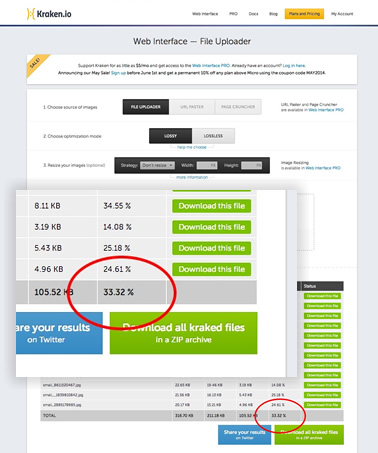
If you’re reading this post on SitePoint, I’m pretty sure I don’t need to explain to you the benefits of having a website.
In short, it’s all about giving visibility, exposure and access to a wider and like-minded audience.
Nevertheless, having the raw technical abilities to launch a site, in no way guarantees its success.
While some problems may fall outside our complete control, often newly launched sites fail because of bad practices and neglected fundamentals.
Today, I’m sharing the five most common mistakes that ruin websites and how to counter them to guarantee you a successful site launch.
Neglecting your Browser Checking
Not checking to see if your website works on the various available browsers out there is one of most common issues newly minted websites have.
As web developers, we can live in ‘bubble’ of high-end computers and browser. But like most products and services, user preferences vary, and this couldn’t be truer than when it comes to browsers.
Web browser usage stats show that as of April 2014 23.2% used Internet Explorer, 20,3% used Firefox, 48.8% used Google Chrome, 5% used Safari and 1.43% used Opera.
Source: StatCounter Global Stats – Browser Market Share
Ultimately, it doesn’t matter if you are a fan of ‘Browser A’ or hate ‘Browser B’, if your audience is using it. The point is to make sure that the site is accessible and usable for whomever comes to it.
Remember you are designing for the visitor.
Solution:
How do you get around such problems?
The obvious solution here is to cross-browser check to ensure that your site is compatible and operational. This doesn’t have to mean keeping a suite of browsers and OS version on call — though nothing beats testing in real browsers — as there are tons of apps out there designed for this.
BrowserShots, CrossBrowserTesting and Lunascape are some tools that you can use to check your site’s compatibility.
Not Paying Enough Attention to Site Promotion

Sometimes it’s easy to become so totally immersed in the construction phase of a website production, that you ‘neglect your baby’ the moment it’s born.
Your work is not done!
Word of mouth has always been a critical aspect of transferring ideas and information. Thankfully, technology has meant getting the “word” out there has become a lot easier than ever before. However it’s also a much more crowded arena.
When you fail to market your site you are essentially flushing money time and effort, and no one wants that.
Of course there are ways to combat that after your site launch, but that requires you to double your efforts. Efforts you won’t have to take as long as you apply appropriate and useful marketing strategies prior to making your site live.
Solution:
How do you employ helpful marketing strategies to get your website some ‘air-time’?
The first is to tell everyone you know. This includes family, friends, co-workers and groups that you take part in.
Don’t think that “they won’t visit” or “this isn’t their type of site” hinder you. The more people you tell, the more likely they are to tell people they know who might benefit from your site’s existence.
Social-networking is a powerful resource and you should use it to the best of your abilities.
You don’t have to explain exactly what your site is for; in fact, you can keep it secretive and just drop small hints here and there. Just create anticipation and of course provide links and contact information so that people can stay informed.
If you have access to do so, take out some online ads on well-known sites in the same niche as yours or even try to get an interview on popular platforms.
Just make sure you save some energy for putting your site out there.
Neglecting SEO
Often when you mention SEO to web designer/developers, there’s nervous shuffling and muttering about ‘dark arts’ and ‘witchcraft’. Sure, you need to be aware of shady practices and practitioners, but good quality SEO, like any good marketing expense, is simply money in the bank.
Like bad shop signage, poor SEO will make it hard for visitors to find you.
If you don’t understand ‘keyword density’ or ‘metadata’, hand the reins over to someone who knows what they are doing.
Solution:
How do you counter this problem?
First, use a well-regarded SEO professional if you are not entirely sure how to best implement SEO. Like finding a good mechanic, a good SEO consultant if someone you’ll want to hold on to.
If you’re taking charge of your own SEO, spend time researching the right keywords for both a broad and targeted spectrum. You can easily run these words through keyword search tools like Google Adwords and Wordstream.
Back in 2011, Kristen Holden wrote ‘The 10 Commandments of SEO‘, but it still makes great sense today.
Make sure that the content and titles are related. Most importantly don’t forget to set up 301 redirects from all important pages on the old sites, make double check they properly.
Generating Bad Content

There are many ways to railroad your site launch, but perhaps the most common ways to do this is to simply produce poor content.
Even well-established sites have been known to fall victim to this malpractice, re-launching with ‘lorem ipsum’ text and placeholder photos.
Often times, those involved in the website launch can be so excited by the technical challenges that they forget to adequately proofread their content. There is also the problem of trying to save money which can diminish the quality of your overall design thanks to purchasing low-quality graphics and photos.
This poor content can be anything from text, graphics, photography and even videos and immediately undermines your credibility in the eyes of your visitors.
You may well be offering an amazing product or service, but visitors will find it tough to look past your grammatical and graphical mistakes.
Spelling or grammatical errors should be the easiest technical errors to locate — but are still surprisingly common. Ensure that any graphics or photos on your site display properly and are of a high-quality.
All of your content and graphics need to be thoroughly reviewed by someone other than their creator before pressing that launch button.
Fresh eyes are a must. In my experience, it’s often the company receptionist, the accountant or even someone’s dad that finds the howling mistake. Get that site in front of people you know.
For better loading times, you will want to make sure that all images are optimized for the web. Often you will inherit imagery from older sites or projects, and you will probably have no idea whether these images were optimized when they were created.
An online tool such as Kraken.io, that can process entire folders of imagery at once, can be great value at launch time.
It’s also very easy to employ a link checking service like Link Alarm to monitor your site for dud links.
Also, make sure the HTML of your elements is displaying correctly and that all content new and old is consistently formatted.
While I don’t subscribe to the ‘all HTML pages should validate’ school of thought, HTML validators can still be very useful for pinpointing potential problems. Your site may not need to validate, but at least review the validation errors for ‘howlers’.
In short, humans make mistakes. Bots are disciplined. Use automated services to detect problems whenever you can.
These fixes should keep your site looking coherent.
Conclusion
Of course, this is just the tip of the iceberg when it comes to ensuring a successful launch for your new or redesigned website. There is no definitive method to avoiding all hiccups in your site launch, but if you follow some of the tips listed above you can avoid a lot of problems in the long run.
What are some other ways that can ruin your site launch?
Do you have any recommendations on how to avoid such disasters?
 Gabrielle Gosha
Gabrielle GoshaGabrielle is a creative type who specializes in graphic design, animation and photography.




